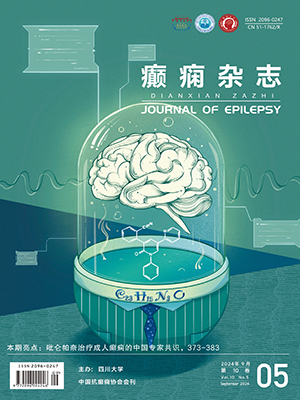| 1. |
赵滢, 章清萍, 包新华. 早发性癫痫脑病遗传学研究进展. 中国实用儿科杂志, 2015, (4): 310-314.
|
| 2. |
Berg AT, Berkovic SF, Brodie MJ, et al. Revised terminology and concepts for organization of seizures and epilepsies: report of the ILAE Commission on Classification and Terminology, 2005-2009. Epilepsia, 2010, 51(4): 676-685.
|
| 3. |
Pressler RM, Cilio MR, Mizrahi EM, et al. The ILAE classification of seizures and the epilepsies: Modification for seizures in the neonate. Position paper by the ILAE Task Force on Neonatal Seizures. Epilepsia, 2021, (62): 615-628.
|
| 4. |
Schossig A, Bloch-Zupan A, Lussi A, et al. SLC13A5 is the second gene associated with Kohlschütter–Tönz syndrome. J Med Genet, 2017, 54(1): 54-62.
|
| 5. |
Weeke LC, Brilstra E, Braun KP, et al. Punctate white matter lesions in full-term infants with neonatal seizures associated with SLC13A5 mutations. Eur J Paediatr Neurol, 2017, 21(2): 396-403.
|
| 6. |
Bhutia YD, Kopelet JJ, Lawrenceal JJ, et al. Plasma membrane Na(+)-coupled citrate transporter (SLC13A5) and neonatal epileptic encephalopathy. Molecules, 2017, 22(3): 378-393.
|
| 7. |
Westergaard N, Waagepetersen H S, Belhage B, et al. Citrate, a ubiquitous key metabolite with regulatory function in the CNS. Neurochem Res, 2017, 42(6): 1-6.
|
| 8. |
Sauer DB, Song J, Wang B, et al. Structure and inhibition mechanism of the human citrate transporter NaCT. Nature, 2021, 591: 157-161.
|
| 9. |
Huard K, Brown J, Jones J C, et al. Discovery and characterization of novel inhibitors of the sodium-coupled citrate transporter (NaCT or SLC13A5). Sci Rep, 2015, 5(1): 1-13.
|
| 10. |
Matricardi S, Liso PD, Freri E, et al. Neonatal developmental and epileptic encephalopathy due to autosomal recessive variants in SLC13A5 gene. Epilepsia, 2020, (00): 1-12.
|
| 11. |
Yang QZ, Spelbrink EM, Nye KL, et al. Epilepsy and EEG phenotype of SLC13A5 citrate transporter disorder. Child Neurol Open, 2020, 7: 1-7.
|
| 12. |
Thevenon J, Milh M, Feillet F, et al. Mutations in SLC13A5 cause autosomal-recessive epileptic encephalopathy with seizure onset in the first days of life. Am J Hum Genet, 2014, 95(1): 113-120.
|
| 13. |
Nashabat M, Qahtani XA, Almakdob S, et al. The landscape of early infantile epileptic encephalopathy in a consanguineous population. Seizure:Europea J Epilep, 2019, 69: 154-172.
|
| 14. |
Takai A, Yamaguchi M, Yoshida H, et al. Investigating developmental and epileptic encephalopathy using drosophila melanogaster. Int J Mol Sci, 2020, 21(17): 1-40.
|
| 15. |
Kann O. The interneuron energy hypothesis: Implications for brain disease. Neurobiol Dis, 2016, 90: 75-85.
|
| 16. |
Consortium E, Project EPG, Consortium E. De novo mutations in synaptic transmission genes including dnm1 cause epileptic encephalopathies. AmJ Hum Genet, 2014, 95(4): 360-370.
|
| 17. |
Hardies K, Kovel CG, Weckhuysen S, et al. Recessive mutations in SLC13A5 result in a loss of citrate transport and cause neonatal epilepsy, developmental delay and teeth hypoplasia. Brain, 2015, 138(11): 1-13.
|
| 18. |
Klotz J, Porter BE, Colas C, et al. Mutations in the Na(+)/citrate cotransporter NaCT (SLC13A5) in pediatric patients with epilepsy and developmental delay. Mol Med, 2016, 22: 310-321.
|
| 19. |
Alhakeem A, Alshibani F, Tabarki B. Extending the use of stiripentol to SLC13A5-related epileptic encephalopathy. Brain Dev, 2018: 1-3.
|
| 20. |
Bainbridge MN, Cooney E, Miller M, et al. Analyses of SLC13A5-epilepsy patients reveal perturbations of TCA cycle. Mol Genet Metab, 2017, 121(4): 314-319.
|




